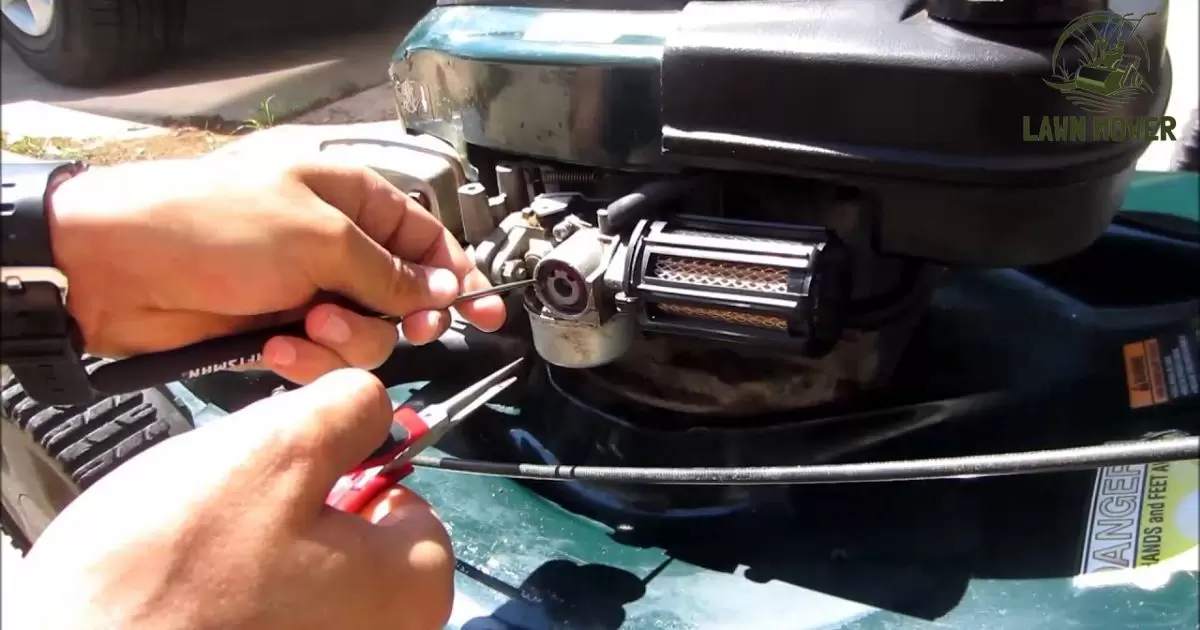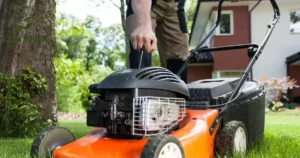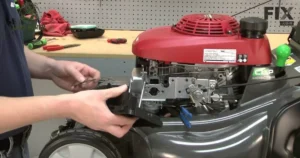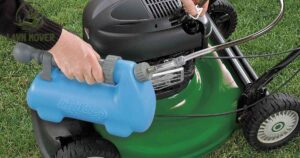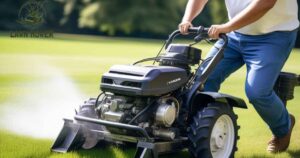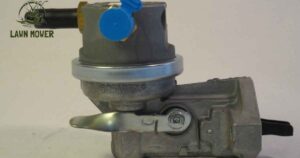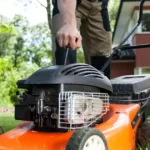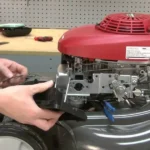Priming a lawn mower without a primer bulb involves manually pouring a small amount of fuel directly into the carburetor to facilitate easier starting. This method helps create the necessary fuel-air mixture for ignition in the absence of a traditional primer bulb.
Reviving your lawn mower without a primer bulb can be a breeze. Wondering, How to Priming a Lawn Mower Without Primer Bulb Fear not – a simple solution awaits. Follow these steps to ensure your mower roars back to life, sans the traditional primer bulb mechanism. Say goodbye to starting troubles with this easy, primer-free technique.
To prime a lawn mower without a primer bulb, fill the gas tank with fresh fuel. Gently push the mower forward and backward to distribute fuel to the carburetor. Pull the starter cord a few times to start the engine, allowing the fuel to reach the combustion chamber.
What You’ll Need

To accomplish the task of priming a lawn mower without a primer bulb, gather the necessary tools and materials. Ensure you have the required equipment, such as screwdrivers, wrenches, and any specific parts or components related to the project. Having a well-organized and complete set of tools, including those needed to prime a lawn mower without a primer bulb, will streamline the process and contribute to a successful outcome.
- Locate The Air Filter
- Identify the air filter on your lawn mower. It is usually a rectangular or cylindrical component positioned near the carburetor.
- Remove The Air Filter
- Carefully remove the air filter cover and take out the air filter. This step allows for better air intake during the priming process.
- Inspect The Carburetor
- Locate the carburetor, which is often situated near the air filter. Inspect it for any visible signs of blockages or debris.
- Fuel System Check
- Ensure that there is sufficient fuel in the mower’s gas tank. If the fuel level is low, fill it with fresh gasoline.
- Fuel Line Inspection
- Examine the fuel line for any kinks, leaks, or blockages. A clear fuel line is crucial for proper fuel delivery to the engine.
- Manual Priming
- In the absence of a primer bulb, manually prime the engine by pouring a small amount of gasoline directly into the carburetor. Be cautious and avoid overfilling.
- Choke Adjustment
- Adjust the choke according to your mower’s user manual. Engage the choke to restrict airflow and enrich the fuel mixture during startup.
- Engine Crank
- Pull the starter cord or use the electric starter to crank the engine. Repeat this process a few times to allow the manually added fuel to circulate within the engine.
- Observe And Adjust
- Pay attention to the engine’s response. If it starts and runs briefly, it indicates successful priming. If not, repeat the process or check for potential issues with the fuel system.
- Replace Air Filter
- Once the engine is running smoothly, replace the air filter and its cover. This helps maintain clean air intake for the engine.
Why Do Lawnmowers Need A Primer Bulb?
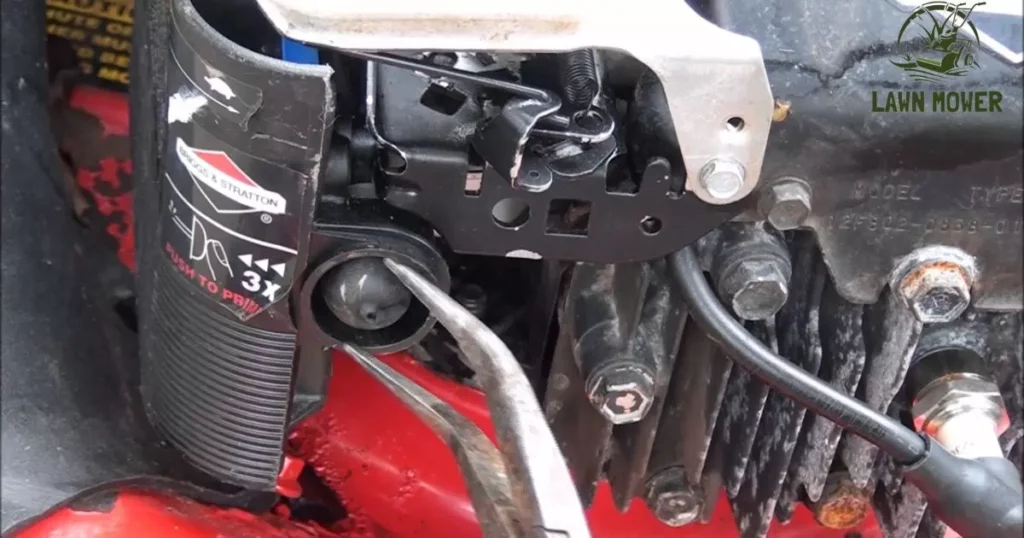
Primer bulbs play a crucial role in lawnmowers by assisting in the initial fueling process. When a lawnmower sits idle for a while, the fuel system can lose pressure, making it difficult to start. The primer bulb acts as a manual pump, injecting fuel directly into the carburetor, ensuring a sufficient amount is present for the engine to ignite.
Prime A Lawn Mower effortlessly with the help of a primer bulb. This small but crucial component simplifies the startup process, providing a quick burst of fuel directly into the carburetor. Especially effective in colder temperatures, the primer bulb ensures faster and more reliable starts, eliminating the frustration often associated with getting a lawnmower running smoothly.
In essence, the primer bulb serves as a handy tool for lawn enthusiasts, promoting efficient and hassle-free lawnmower operation. Its simple yet effective design ensures that the engine receives the proper fuel supply, ultimately contributing to a smoother start and optimal performance every time the lawnmower is used.
Carburetor Without Primer Bulb
A lawnmower’s carburetor without a primer bulb operates differently than those equipped with one. In the absence of a primer bulb, starting the lawnmower involves a manual process. Users must manually engage the choke to enrich the fuel mixture before pulling the starter cord, providing the engine with the necessary fuel-air mixture for ignition.
Without a primer bulb, the starting procedure for a lawnmower may require a few extra pulls of the starter cord compared to mowers with a primer. The absence of this convenient primer bulb feature, such as the one used to Prime A Lawn Mower, means relying on the traditional choke system for cold starts. While it may involve a slightly more hands-on approach, lawnmowers without primer bulbs can still effectively start and perform well with proper operation.
Despite the simplicity of a carburetor without a primer bulb, it requires users to be more mindful of the starting process, especially in colder conditions. While primer bulbs expedite the fuel priming process, lawnmowers without them can still deliver reliable performance when users follow the correct starting procedure, ensuring a well-mixed fuel-air ratio for efficient combustion.
Lawnmower Primer Bulb Not Working
When the lawnmower primer bulb malfunctions, starting the engine becomes a challenge. To address this issue, inspect the bulb for damage and replace it if necessary. If problems persist, check for fuel line blockages or leaks that may affect primer bulb function.
How To Prime A Lawn Mower Without Primer Bulb? In such cases, manually prime the mower by adding a small amount of gasoline directly into the carburetor. Exercise caution and consult your mower’s manual for any model-specific instructions on priming without a functioning primer bulb.
Understand The Fuel System
| Component | Function |
| Fuel Tank | Stores gasoline for the engine. |
| Fuel Cap | Seals the fuel tank and prevents fuel evaporation. |
| Fuel Line | Transfers fuel from the tank to the carburetor. |
| Fuel Filter | Removes impurities and debris from the fuel. |
| Carburetor | Mixes air and fuel in the right proportion for combustion. Adjusts engine speed. |
| Throttle | Controls the amount of air-fuel mixture entering the engine, affecting engine speed. |
| Choke | Adjusts the air-fuel mixture for easier engine starting in cold conditions. |
| Fuel Pump (if equipped) | Transfers fuel from the tank to the carburetor, common in some riding mowers. |
| Fuel Shut-off Valve | Allows manual control of fuel flow to the carburetor. |
| Fuel Injector (if equipped) | Sprays fuel directly into the combustion chamber, common in some modern mowers. |
| Ventilation System | Provides proper air circulation to prevent fuel vapor lock. |
| Fuel Cap Vent (if equipped) | Allows air to enter the fuel tank as fuel is used, preventing a vacuum from forming. |
Preparing The Lawn Mower

Before starting your lawn mower, it’s crucial to ensure it’s properly prepared for optimal performance. Begin by checking the fuel level to guarantee there’s enough gas for the task at hand. This ensures a seamless mowing experience without interruptions.
Ensure your lawn mower is in top-notch condition by checking the oil level and quality for smooth operation. Don’t forget to Prime A Lawn Mower to guarantee optimal performance. Also, inspect the air filter, cleaning or replacing it as needed for efficient engine airflow. These quick steps will keep your mower primed and ready for a successful mowing session, preserving the health and appearance of your lawn.
Troubleshooting Common Issues
When troubleshooting common issues with a lawnmower, start by checking the spark plug. A fouled or damaged spark plug can lead to poor engine performance. Ensure it is clean and properly gapped to facilitate efficient ignition.
Inspect the air filter for any clogs or dirt buildup, especially when looking to “Prime A Lawn Mower.” A dirty air filter restricts airflow, affecting combustion and overall engine function. Regularly cleaning or replacing the air filter helps maintain optimal performance and extends the life of the lawnmower.
If your Greenworks lawnmower won’t start, examine the fuel system. Ensure there is sufficient fuel in the tank and that the fuel is fresh. Stale or contaminated fuel can impede engine operation. Additionally, check for clogged fuel filters and clean or replace them as needed to keep the fuel flowing smoothly. If your Greenworks lawnmower keeps shutting off, it’s essential to address these fuel-related issues promptly.
Tips for Proper Maintenance and Storage of Lawn Mowers
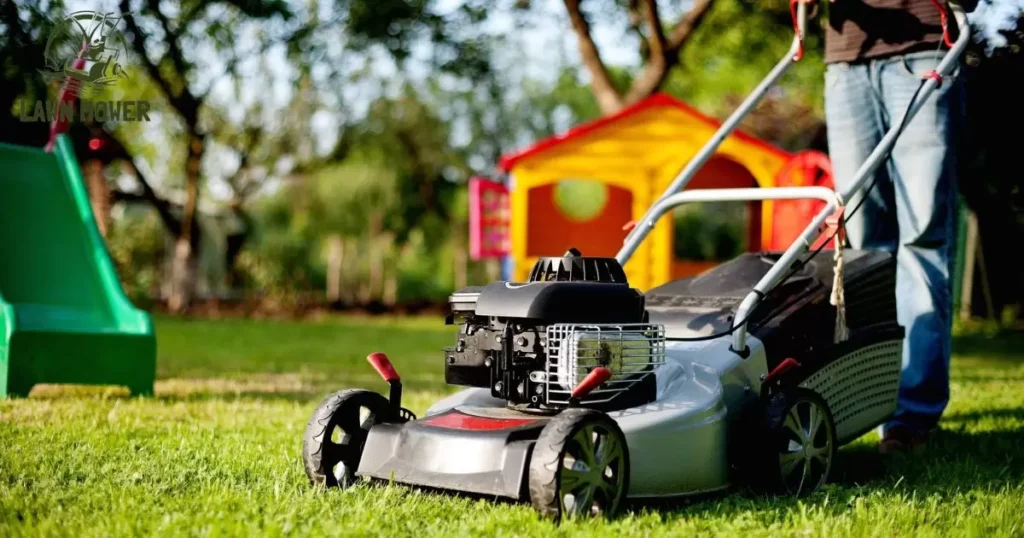
1. Regular Cleaning
Regular cleaning of your lawnmower is crucial to maintain its performance and longevity. After each use, take a few moments to remove grass clippings and debris from the blades and underneath the deck. This prevents clogs, ensures efficient cutting, and promotes a healthier lawn.
Additionally, regularly check and clean the air filter and spark plug. A clean air filter allows the engine to run smoothly, while a well-maintained spark plug ensures reliable ignition. These simple cleaning steps not only enhance the mower’s efficiency but also contribute to a well-groomed and lush lawn.
2. Oil Check and Change
To prime a lawn mower for optimal performance, regularly check and change the oil. Ensure the engine is cool before using the dipstick to gauge the oil level. Top up or change the oil as recommended by the manufacturer for a more efficient and long-lasting lawnmower.
To change the oil, drain the old oil by removing the drain plug or tilting the mower. Dispose of the used oil properly. Then, refill the engine with the recommended oil type and amount. Regular oil maintenance ensures smooth operation, extends the mower’s lifespan, and contributes to a healthier lawn.
3. Air Filter Maintenance
When you Prime A Lawn Mower, pay attention to the gap between the center and ground electrode, as an incorrect gap can impact ignition. Also, check the color of the spark plug’s insulator; it should be light brown, indicating a proper air-fuel mixture. Regular spark plug inspection is a simple yet effective maintenance task for the overall reliability and longevity of your lawnmower.
4. Spark Plug Inspection
Inspecting the spark plug of your lawnmower is crucial for optimal performance. Check for any signs of wear or carbon buildup on the electrode, which can hinder proper ignition. A clean and well-maintained spark plug ensures efficient fuel combustion, promoting a smooth-running lawnmower.
Keep an eye out for the gap between the center and ground electrode when you Prime A Lawn Mower, as an incorrect gap can affect ignition. Additionally, examine the color of the spark plug’s insulator; it should be light brown, indicating a proper air-fuel mixture. Regular spark plug inspection is a simple yet effective maintenance task that contributes to the overall reliability and longevity of your lawnmower.
5. Blade Care
Proper blade care is essential for maintaining the efficiency and longevity of your lawnmower. Sharpen the blade regularly to ensure a clean and precise cut, preventing grass from tearing and leaving your lawn looking neat and healthy.
Regularly check and maintain your lawnmower for optimal performance. Inspect and address blade issues promptly, keep it clean from grass buildup, and Prime A Lawn Mower before each use to ensure a smooth and efficient cutting experience, extending the machine’s lifespan.
6. Fuel System Care
Proper maintenance of a lawnmower’s fuel system is essential for optimal performance. Keep the fuel tank clean and free from debris to prevent clogs and ensure a smooth fuel flow to the engine. Additionally, use high-quality fuel and additives to minimize carburetor buildup, promoting a more efficient combustion process.
Regularly inspect the fuel filter and replace it as needed to maintain a clean fuel supply. When storing the lawnmower for an extended period, consider using a fuel stabilizer to prevent fuel degradation. Prime A Lawn Mower by following these simple steps, which contribute to the longevity of the fuel system, ensuring your lawnmower is always ready to tackle the task at hand.
7. Primer Bulb Use
Press the primer bulb on your lawnmower to manually draw fuel into the carburetor, ensuring a smooth start. This small, rubber bulb serves as a quick and effective way to prime the engine, especially after extended periods of inactivity.
Prime A Lawn Mower by giving the primer bulb 2-3 squeezes before starting. This quick step ensures the carburetor receives the right fuel-air mixture, boosting engine performance and making ignition a breeze. Keep your lawnmower running smoothly with this easy and effective method.
8. Proper Storage
To effectively Prime A Lawn Mower, prioritize meticulous storage. After cleaning the mower and removing debris, store it in a dry, sheltered area to safeguard against the elements and prevent rust. This simple yet crucial step ensures your lawnmower stays in peak condition for reliable performance when you need it.
Additionally, before storing, empty the fuel tank or add a fuel stabilizer to prevent fuel-related issues. Place the lawnmower on a clean surface, elevate the wheels, and cover it with a protective sheet. These simple storage practices can significantly prolong the life and efficiency of your lawnmower, ensuring it’s ready to tackle the next season’s lawn maintenance tasks.
9. Battery Maintenance (if applicable)
Proper care of your lawnmower’s battery, especially when aiming to Prime A Lawn Mower, is essential for optimal performance. Ensure the battery terminals are clean and free of corrosion, promoting a reliable electrical connection. Regularly check the electrolyte levels if applicable, and top up with distilled water as needed to prolong the battery’s life.
Store the lawnmower in a cool, dry place when not in use to prevent the battery from discharging quickly. If the lawnmower features a rechargeable battery, follow the manufacturer’s guidelines for charging intervals to maintain a healthy battery. Taking these simple steps can significantly extend the lifespan of the lawnmower’s battery, ensuring it’s always ready for the next mowing session.
10. Read The Manual
Take a moment to read your equipment’s manual carefully. It provides valuable insights into proper usage, maintenance, and troubleshooting. Understanding the manual ensures you get the most out of your tool and helps prevent avoidable issues.
Frequently Asked Questions
What is a primer bulb?
A primer bulb is a small, flexible device in a fuel system that manually pumps fuel into the carburetor, facilitating easier starting of engines such as those in lawn mowers or small equipment. It helps create a fuel-rich mixture for initial ignition.
Do all lawn mowers need to be primed?
No, not all lawn mowers need to be primed. Some modern models feature a primer bulb for easier starting, while others have alternative starting mechanisms.
Do you need a primer bulb?
Yes, a primer bulb is necessary for some small engines as it helps facilitate the fuel delivery process by creating the initial vacuum needed for starting. It ensures proper fuel flow and enhances the engine’s performance.
How do you prime a lawn mower carburetor?
To prime a lawn mower carburetor, locate the primer bulb, press it 3-5 times to draw fuel into the carburetor, and then start the engine.
Conclusion
Priming a lawnmower without a primer bulb involves manually adding fuel to the carburetor. This can be done by pouring gasoline directly into the carburetor or following alternative methods suggested by the manufacturer. For those facing a mower without a primer bulb, this unconventional approach ensures a smooth start by providing the necessary fuel to the engine.
If you’re asking yourself, How To Prime A Lawn Mower Without Primer Bulb? follow the manufacturer’s guidelines for the correct technique. Whether introducing fuel carefully or using recommended methods, these approaches help maintain your lawnmower’s functionality without relying on a traditional primer bulb.

With a wealth of expertise spanning six years, I am a seasoned professional in the realm of lawn mowers. My mastery includes intricate knowledge of models, maintenance, and optimal performance.
